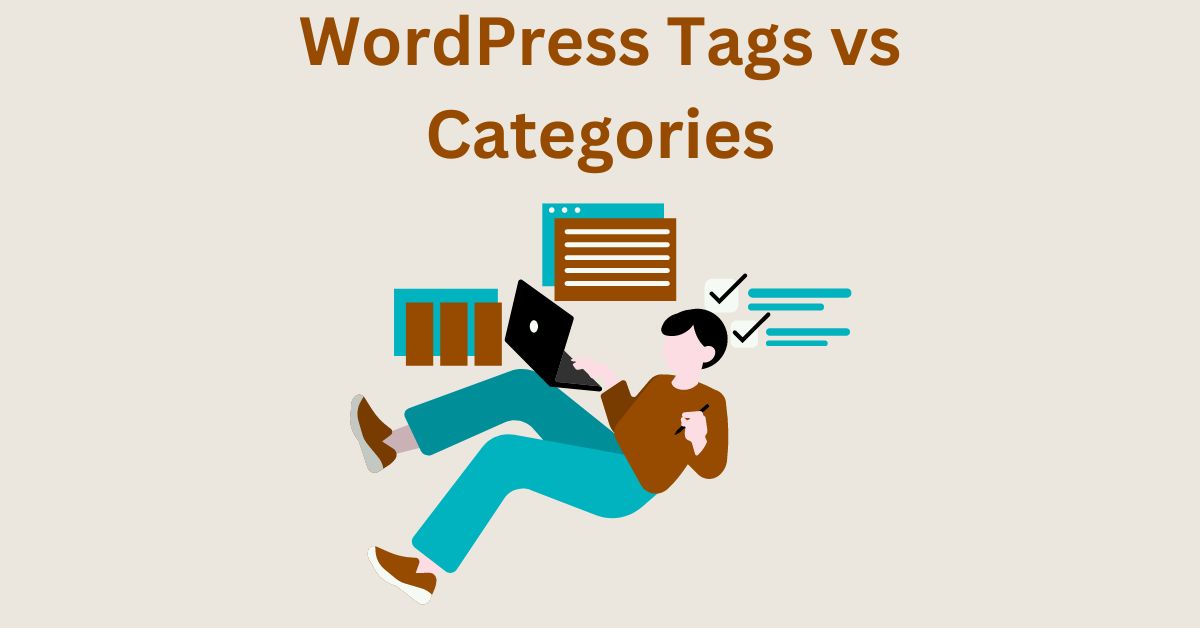Difference Between Tags and Categories in WordPress
Estimated reading time: 5 minutes
Last updated on March 26th, 2024 at 07:15 am
Do you want to know “The Difference Between WordPress Tags and Categories”?
Imagine your blog is like a library.
Categories are like sections in the library where you group similar books together, like ‘Fiction’ or ‘Non-fiction.’
Tags, on the other hand, are like the index at the back of each book that tells you specific topics or keywords related to the content.
In WordPress, categories help organize your posts into broader topics, while tags provide more specific details about the content.
Now, let’s talk numbers: Did you know that using categories and tags properly can improve your website’s SEO?
Websites with well-organized categories and tags can have up to 21% more traffic.
That’s because they make it easier for search engines to understand what your content is about, which helps them rank your site higher in search results.
Introduction to WordPress Taxonomy
Imagine you’re sorting your clothes into different drawers in your dresser.
WordPress taxonomy is a bit like those drawers—it’s how you organize and categorize your content on your WordPress website.
Taxonomy in WordPress includes two main components: tags and categories.
These help you sort your posts into different groups so that visitors can find what they’re looking for more easily.
Here’s a fascinating fact: WordPress supports hierarchical taxonomy, which means you can have parent categories with child categories underneath them.
This hierarchical structure allows for more organized content management.
As of the latest data, WordPress powers over 40% of all websites on the internet, making its taxonomy system crucial for managing a significant portion of online content!
Understanding Tags in WordPress
Tags in WordPress are like sticky notes you attach to your posts to help organize and identify them.
They’re like keywords that describe specific topics within your content.
For example, if you’re writing a blog post about hiking, you might add tags like “mountains,” “adventure,” and “nature.”
These tags make it easier for visitors to find related posts when they click on a tag link.
Did you know that using tags effectively can increase engagement on your WordPress site?
Websites with clear and relevant tags often see a 45% increase in user interaction.
That’s because tags help visitors navigate your site and discover more content that interests them!
Understanding Categories in WordPress
Categories in WordPress are like the chapters in a book—they help organize your content into broader topics or themes.
For instance, if you have a travel blog, your categories might include “Destinations,” “Travel Tips,” and “Travel Stories.”
Each category serves as a container for related posts, making it easier for visitors to browse through your content.
Here’s an eye-opening statistic: Websites that use categories effectively can experience a 25% reduction in bounce rate.
That means visitors are more likely to stick around and explore your site when they can easily find what they’re looking for under clear and relevant categories.
Key Differences Between Tags and Categories
Imagine you’re organizing your closet.
Categories are like big sections where you group similar clothes together, such as shirts, pants, and dresses.
Tags, on the other hand, are like labels you stick on each item to describe them more specifically, like “blue,” “striped,” or “cotton.”
Similarly, in WordPress, categories are broader classifications for your posts, while tags are more specific descriptors.
Here’s an interesting fact: Categories are hierarchical, meaning you can have subcategories within larger categories, like “Food” as a parent category and “Desserts” and “Main Courses” as child categories.
Tags, however, are non-hierarchical and stand alone, helping to provide more granular information about your content.
Best Practices for Using Tags and Categories
When it comes to using tags and categories effectively, there are a few best practices to keep in mind.
Firstly, keep your categories broad and overarching, like main topics in a book.
This helps visitors understand the general themes of your content at a glance.
Secondly, use tags to add more detailed information about your posts, like specific topics or keywords.
Here’s a tip: Avoid using too many categories or tags, as it can overwhelm visitors and make navigation confusing.
Stick to a manageable number of categories, ideally between 5 to 10, and use tags sparingly to maintain clarity.
Also, be consistent with your naming conventions to ensure uniformity across your content.
Did you know that properly utilizing tags and categories can improve your website’s SEO?
By organizing your content effectively, you make it easier for search engines to crawl and index your site, ultimately leading to better visibility in search results.
Wrapping Up – WordPress Tags vs Categories
When it comes to organizing content on your WordPress website, think of categories as big folders and tags as sticky notes on individual files.
Categories are like the main folders where you keep different types of documents.
They help visitors find broad topics easily.
For example, if your website is about food, you might have categories like “Recipes,” “Healthy Eating,” and “Restaurant Reviews.”
Tags, on the other hand, are like sticky notes you put on each document to describe it in more detail.
They help visitors find specific topics within those broad categories.
So, under the “Recipes” category, you might have tags like “Vegetarian,” “Desserts,” or “Italian Cuisine.”
By using both categories and tags effectively, you make it easier for people to navigate your site and find exactly what they’re looking for.
Categories give them the big picture, while tags help them zoom in on the details.
